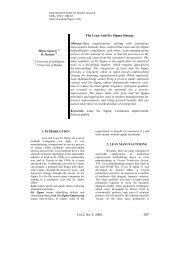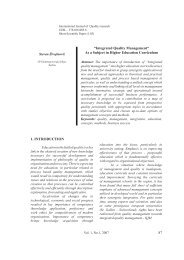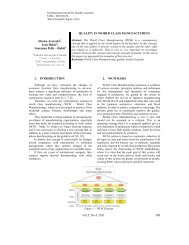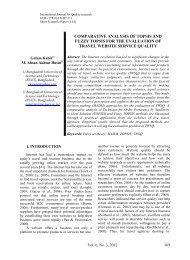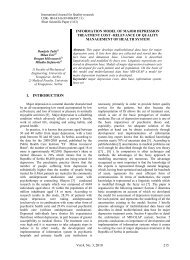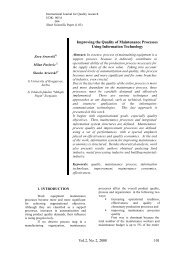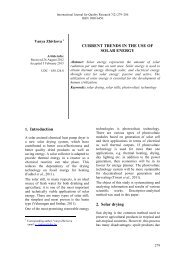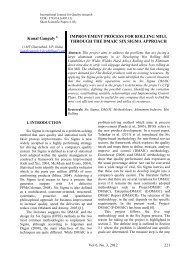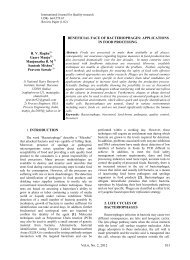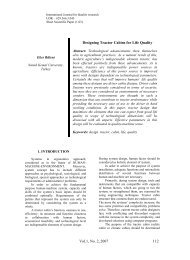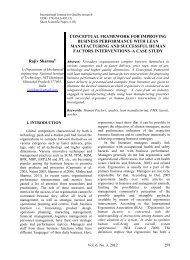transactional and transformational leadership - International Journal ...
transactional and transformational leadership - International Journal ...
transactional and transformational leadership - International Journal ...
Create successful ePaper yourself
Turn your PDF publications into a flip-book with our unique Google optimized e-Paper software.
<strong>International</strong> <strong>Journal</strong> for Quality research<br />
UDK- 378.014.3(497.11)<br />
Short Scientific Paper (1.03)<br />
Srđan Nikezić 1)<br />
Sveto Purić 2)<br />
Jelena Purić 3)<br />
1) Faculty of Science,<br />
University of Kragujevac,<br />
Serbia<br />
srdjan_nikezic@yahoo.com<br />
2) Faculty of Law, University<br />
of Kragujevac, Serbia<br />
svetopuric@yahoo.com<br />
3)Faculty of Economics,<br />
University of Kragujevac,<br />
Serbia<br />
jecapuric@yahoo.com<br />
TRANSACTIONAL AND TRANSFORMATIONAL<br />
LEADERSHIP: DEVELOPMENT THROUGH CHANGES<br />
Abstract: The success <strong>and</strong> rewarding are mostly expressed in<br />
business performance at the end of the year. Transactional <strong>and</strong><br />
<strong>transformational</strong> <strong>leadership</strong> as a new paradigm of quality<br />
effects on creation of roles <strong>and</strong> processes in the organization.<br />
From the leaders are expected to use <strong>leadership</strong> as a process<br />
of ensuring the long-term goals of the organization, especially<br />
in turbulent competitive environment. Therefore, this paper<br />
points out the impact of <strong>leadership</strong> competencies through<br />
<strong>transactional</strong> <strong>and</strong> <strong>transformational</strong> <strong>leadership</strong>, characteristics<br />
<strong>and</strong> processes that show different levels of participation of<br />
transformation <strong>and</strong> <strong>transactional</strong> <strong>leadership</strong> of organizations.<br />
Keywords: leader, followers, changes, <strong>transactional</strong> <strong>and</strong><br />
transformat <strong>leadership</strong>, organization<br />
1. Introduction<br />
Theory <strong>and</strong> practice show that <strong>transactional</strong><br />
<strong>leadership</strong> is a necessary, evolutionary path toward<br />
<strong>transformational</strong> <strong>leadership</strong> from the relatively<br />
stable to a period of business in a turbulent<br />
environment, which is characterized by many<br />
unknowns. For <strong>transformational</strong> <strong>leadership</strong> is<br />
characteristic interaction of different social actors,<br />
initiative, efficiency <strong>and</strong> effectiveness, readiness<br />
for change <strong>and</strong> variety of strategic choices in<br />
accordance with the requirements of the<br />
environment <strong>and</strong> the perception of new vision <strong>and</strong><br />
business goals. It is an evolutionary path that<br />
coexists with the changes in the environment <strong>and</strong><br />
<strong>transformational</strong> <strong>leadership</strong> inevitably occur as a<br />
complex process based on the individual vision,<br />
courage <strong>and</strong> willingness to learn, openness to<br />
followers <strong>and</strong> values that include better <strong>and</strong> more<br />
efficiently, based on the radical changes in the<br />
organization <strong>and</strong> the environment.<br />
Cox identified two basic types of <strong>leadership</strong>:<br />
<strong>transactional</strong> <strong>and</strong> <strong>transformational</strong>. [17]<br />
Differences between <strong>transactional</strong> <strong>and</strong><br />
<strong>transformational</strong> <strong>leadership</strong> was first formulated<br />
by Downton, but the idea is worked out by James<br />
MacGregor Burns in 1979. Burns made a<br />
distinction between ordinary (<strong>transactional</strong>)<br />
leaders, who have ensured the followers loyalty<br />
through rewards, <strong>and</strong> extraordinary<br />
(<strong>transformational</strong>) leaders, which focused on the<br />
essential needs of followers. The idea was further<br />
developed by Bernard Bass who was considering,<br />
unlike Burns's, that <strong>transformational</strong> <strong>and</strong><br />
<strong>transactional</strong> leaders are part of the same<br />
continuum of <strong>leadership</strong> that can not be<br />
considered separately. [18]<br />
2. Transactional <strong>leadership</strong><br />
The concept of <strong>transactional</strong> <strong>leadership</strong> was first<br />
mentioned by Max Weber in his socio-economic<br />
considerations of the organization. Twenty-seven<br />
years after his death <strong>and</strong> publishing a reprint of his<br />
book, academic <strong>and</strong> professional audience accepts<br />
his definition of <strong>leadership</strong>. [1] Max Weber first<br />
described <strong>transactional</strong> <strong>leadership</strong> style <strong>and</strong> his<br />
basic facts are accepted by Bernard Bass in 1981.<br />
Great influence on him had made James<br />
McGregor Burns-a [2], whose study of <strong>leadership</strong><br />
was the cornerstone for further development of<br />
<strong>leadership</strong> as a new area.<br />
Vol 6, No. 3, 2012 285
THREE OPTIONS<br />
FOR THE Capitalist<br />
Entrepreneur<br />
1. Charismatic<br />
(Transformer)<br />
An individual personality<br />
set apart form ordinary<br />
people <strong>and</strong> endowed with<br />
supernatural, superhaman<br />
powers, <strong>and</strong> heroic<br />
qualities. In short part<br />
Hero, <strong>and</strong> part Superman/<br />
Superwoman.<br />
2. Bureaucratic<br />
(Transactional)<br />
Bureaucracy is "the<br />
exercise of control on<br />
the basis of<br />
knowledge: (p. 339). It<br />
is the stuff of rational<br />
legal hierarchical<br />
power, the<br />
Bureaucratic leader.<br />
3. Traditional<br />
(Feudal)<br />
Traditional is an<br />
arbitrary exercise of<br />
Sultan power bound to<br />
loyalty, favoritism, <strong>and</strong><br />
politics. It is stuff of<br />
Princely <strong>leadership</strong>.<br />
Figure 1: Max Weber's (1947) Model of<br />
Transaction <strong>and</strong> Transformation Leadership<br />
Authority<br />
Max Weber has defined three types of <strong>leadership</strong><br />
<strong>and</strong> leaders:<br />
Bureaucratic - <strong>transactional</strong> leaders,<br />
who earns <strong>leadership</strong> through normative rules <strong>and</strong><br />
regulations, strict discipline <strong>and</strong> systematic<br />
control. Obedience of followers is based on<br />
rational values <strong>and</strong> rules, <strong>and</strong> also on established<br />
agreements. Follower is limited to the obligations<br />
<strong>and</strong> controls which are set him. Wages are fixed<br />
<strong>and</strong> ranked in a hierarchy. Coercive measures are<br />
clearly defined <strong>and</strong> their use is subject to certain<br />
conditions that are already established. The<br />
technical side of follower has big importance <strong>and</strong><br />
forms the basis for the selection of administrative<br />
staff. There is no right of appeal. Capitalism,<br />
according to Weber, encourages the development<br />
of bureaucracy, even bureaucracy exist in socialist<br />
systems. [1, 339]<br />
Traditional leaders believe in the<br />
legitimacy of governance on traditional way.<br />
Personal loyalty <strong>and</strong> faithfulness of followers<br />
dominant in this kind of <strong>leadership</strong>. The <strong>leadership</strong><br />
of the organization is characterized by<br />
arbitrariness <strong>and</strong> iracionalnoscu instead of<br />
rationality <strong>and</strong> economic activity. [1, 335]<br />
Examples include: a feudal kingdom in China,<br />
Egypt, Africa, the Roman Empire <strong>and</strong> others.<br />
• Charismatic leader is characterized by<br />
dedication, illumination, <strong>and</strong> heroism. Followers,<br />
on the basis of personal trust in the leader <strong>and</strong> his<br />
intention, consciously accept to belief in his<br />
charisma, vision <strong>and</strong> mission. He is for them like a<br />
warrior, prophet or a visionary. Because of<br />
consideration that charisma is God's gift, leader<br />
being treated in such a way. Weber watched<br />
charismatic leaders as: heroes in the war, leaders<br />
of the hunt, the wise men or shamans, <strong>and</strong> also as<br />
founders of religions like Christ in Christianity or<br />
Muhammad in Islam. Thus, one type of charisma<br />
is a hereditary monarchy, the second patriarchal<br />
authority, the third charismatic religious authority,<br />
<strong>and</strong> the fourth military heroes.<br />
Weber argued that no one of three leaders types<br />
occur an ideal form. [1, 329-333] Also argued that<br />
there can be a combination of bureaucratic <strong>and</strong><br />
charismatic <strong>leadership</strong>.There are a few strongholds<br />
in his conception of Leadership:<br />
• Weber's model of <strong>leadership</strong> is dynamic <strong>and</strong><br />
allows the transfer of <strong>leadership</strong> from one form to<br />
another. There is no ideal type of <strong>leadership</strong><br />
• The model is cyclical, that is an unstable<br />
form of charismatic, bureaucratic form can<br />
become a hybrid of the monarchy at the top.<br />
• Model has situational character, because<br />
Weber explained the economic <strong>and</strong> social<br />
conditions that support the selection of a particular<br />
type of <strong>leadership</strong>.<br />
• Weber st<strong>and</strong>s for the transformation of<br />
charisma into a democratic approach to <strong>leadership</strong>,<br />
which respect the voice of followers. The new<br />
charismatic authority is based on legitimacy <strong>and</strong><br />
public recognition. Weber's opinion is that antiauthoritarian<br />
direction of the transformation of<br />
charisma present the way towards greater<br />
rationality. [1, 390]<br />
Bernard Bass, using Burns basis of a<br />
<strong>transactional</strong> leader, start with characteristics of<br />
behavior <strong>and</strong> situation as basic level of exchanges<br />
between leaders <strong>and</strong> followers, so that all<br />
participants get something they want. He<br />
identified two types of <strong>leadership</strong>: <strong>transactional</strong><br />
<strong>and</strong> <strong>transformational</strong>.<br />
Transactional <strong>leadership</strong> is based on classical<br />
principles of exchange with followers who are part<br />
286 K.Ganguly
of interactions <strong>and</strong> therefore are rewarded for<br />
meeting pre-defined st<strong>and</strong>ards <strong>and</strong> performance.<br />
Transactional <strong>leadership</strong> is focused on maintaining<br />
the status quo, so <strong>transactional</strong> <strong>leadership</strong> present<br />
traditional approach of <strong>leadership</strong>. [3] First Bass's<br />
research of <strong>transactional</strong> <strong>and</strong> <strong>transformational</strong><br />
<strong>leadership</strong> is related to the year of 1954 <strong>and</strong> 1960,<br />
when the practical examples found correlation<br />
between successful <strong>leadership</strong> <strong>and</strong> perceptual<br />
flexibility. He also came to the conclusion that<br />
<strong>transactional</strong> leaders can be successful in a short<br />
period of time, but that they must focus on the<br />
changes, if you want to continue to retain a<br />
<strong>leadership</strong> position.[4, 5] Transactional <strong>leadership</strong><br />
style commonly used in conditions where the<br />
focus of leaders focused on the basic process<br />
control, organization <strong>and</strong> short-term planning.<br />
Examples for <strong>transactional</strong> leaders are American<br />
<strong>and</strong> French politicians McCarthy <strong>and</strong> de Gaulle.<br />
Transactional <strong>leadership</strong> is utilized in the economy<br />
after the Second World War until the 70's, because<br />
the business climate, particularly in the United<br />
States, provided high level of stability that most<br />
organizations did not felt the need for change, <strong>and</strong><br />
consequently for the <strong>leadership</strong>, as the power that<br />
leads to changes. [6] Transactional <strong>leadership</strong><br />
involves motivating <strong>and</strong> directing followers,<br />
appealing to their own interests. The power of the<br />
leader comes from formal authority <strong>and</strong><br />
responsibility in the organization.The main task of<br />
the followers to respect the instructions of leaders.<br />
The leader provides rewards <strong>and</strong> punishments in<br />
the organization of its legitimacy. Transactional<br />
<strong>leadership</strong> is, in essence, oriented on monitoring<br />
organization, processes <strong>and</strong> outcomes in the<br />
market. [7] The interpersonal relationships<br />
between leaders <strong>and</strong> followers have a four<br />
dimensional approach:<br />
1) The possibility of reward, as a result of wellperformed<br />
tasks <strong>and</strong> achieved goals that followers<br />
are expected to successfully completed the<br />
process. Goals must be specific, measurable,<br />
possible, realistic <strong>and</strong> timely manner (SMART).<br />
2) Actively engaging leaders in managing, which<br />
followed the work of his followers, gives<br />
consideration to any deviation from established<br />
st<strong>and</strong>ards <strong>and</strong> procedures by taking corrective<br />
measures in case of errors.<br />
3) Passive engagement leader involves the leaders<br />
in the process only when st<strong>and</strong>ards are not met, or<br />
performance are not achieved.<br />
4) Laissez-Faire dimension, which is a form of<br />
<strong>leadership</strong> that provides the possibility of freedom<br />
in the choice of goals <strong>and</strong> behavior of<br />
organizational participants. It is not real <strong>leadership</strong><br />
style, because of impact of social actors, whose<br />
activities were not coordinated, limited or<br />
formalized. The leader avoids responsibility for<br />
decision-making <strong>and</strong> because of that he often<br />
creates inefficient <strong>and</strong> unprofitable organizational<br />
relationships. [8] Assumptions of <strong>transactional</strong><br />
<strong>leadership</strong> are:<br />
• employees are motivated leader through rewards<br />
<strong>and</strong> punishments,<br />
• followers receive a directive from the leader,<br />
wich mast be respected through production<br />
process,<br />
• there is no self-motivation, but the follower are<br />
controlled by leader during the manufacturing<br />
process.<br />
Transactional leaders are focused on shortterm<br />
goals, st<strong>and</strong>ards, procedures, rules <strong>and</strong><br />
control. Creativity, vision <strong>and</strong> generating of new<br />
ideas are not represented. The efficiency (cost<br />
reduction) is the key variable of <strong>leadership</strong><br />
competencies. The left side of the brain (rational<br />
behavior), completely dominated, so the right<br />
brain (emotional intelligence) is totally excluded<br />
from <strong>leadership</strong> behavior. Followers are motivated<br />
only by rewards <strong>and</strong> punishments, <strong>and</strong> the utility<br />
over money dominates the leader-followers.<br />
Transactional <strong>leadership</strong> focuses on the basic<br />
functions of management, control, organization<br />
<strong>and</strong> short-term planing.<br />
Transactional <strong>leadership</strong> is based on the<br />
assumption that employees are motivated by the<br />
best system of rewards <strong>and</strong> punishments.<br />
Transactional leaders are focused on st<strong>and</strong>ards,<br />
policies <strong>and</strong> procedures, as we have already said.<br />
They have a very narrow focus <strong>and</strong> do not<br />
encourage the creativity <strong>and</strong> new ideas. This style<br />
of <strong>leadership</strong> works best when organizational<br />
problems are simple <strong>and</strong> clearly defined. [9]<br />
Inflexibility of <strong>leadership</strong> is a characteristic of this<br />
model, so any attempt to change this <strong>leadership</strong><br />
style is difficult <strong>and</strong> almost unsuccessful, because<br />
the <strong>leadership</strong> style is part of human person, his<br />
personal characteristics <strong>and</strong> that is something<br />
unchangeable. [10]<br />
Vol 6, No. 3, 2012 287
3. Transformational Leadership<br />
As a term, <strong>transformational</strong> <strong>leadership</strong> first<br />
was mentioned in 1973rd, in the J. V. Dowton's<br />
sociological study,. [11] Transformational<br />
<strong>leadership</strong> style is directly related to charismatic<br />
<strong>leadership</strong> approach, since Max Weber's time.<br />
Robert House in 1976th , start approuching the<br />
traditional literature on charisma <strong>and</strong> charismatic<br />
leader, <strong>and</strong> concluded that through the selected<br />
literature from social psychology can be explaned<br />
on a relevant way the concept of charisma. House<br />
has considered a range of topics related to<br />
charisma, including the charismatic effects,<br />
characteristics of charismatic leaders, their<br />
behavior, <strong>and</strong> situational factors that influence on<br />
appearance <strong>and</strong> effectiveness of charismatic<br />
leaders. Based on these analyzes he was developed<br />
speculatively theoretical explanation of charisma<br />
starting from psychological forms, including a less<br />
sociological <strong>and</strong> political considerations. [12]<br />
Musser was observed a charismatic leader as<br />
holder of double function: he seeks to wake up<br />
feelings to followers for ideological commitment<br />
to the goals <strong>and</strong> devotion to his own personality.<br />
Which of these two objectives will be dominant<br />
depends on the motives <strong>and</strong> needs of the leader.<br />
[13] Conger <strong>and</strong> Kanungo give five attributes<br />
(characteristics) of charismatic leaders:<br />
• vision <strong>and</strong> articulation,<br />
• responsibility for Environment,<br />
• underst<strong>and</strong>ing followers needs,<br />
• personal risk taking <strong>and</strong><br />
• unconventional behavior. [14]<br />
James MacGregor Burns has made a<br />
fundamental distinction between <strong>transactional</strong> <strong>and</strong><br />
<strong>transformational</strong> <strong>leadership</strong>. [2, 15]<br />
Transformational leaders seek to change existing<br />
patterns, values, beliefs <strong>and</strong> goals, <strong>and</strong> create new<br />
ones that encourage the greater commitment.<br />
Intense commitment to the concept of<br />
<strong>transformational</strong> <strong>leadership</strong> is the result of at least<br />
two tendencies. First, many large companies such<br />
as IBN, GM, Ford <strong>and</strong> others, started a<br />
comprehensive program of transformation <strong>and</strong><br />
change that had to be achieved in a relatively short<br />
period of time, because in early 80-ies of last<br />
century business world has become more<br />
dynamic, competitive <strong>and</strong> volatile. Many, by then<br />
a successful company, were faced with the crisis<br />
<strong>and</strong> the need to radically change their former way<br />
of <strong>leadership</strong>. Second, the recent theoretical base<br />
of <strong>leadership</strong>, which is based on an analysis of<br />
personal leader characteristics <strong>and</strong> behavior in<br />
different situations, not taking into consideration<br />
certain, quite unusually, quality of leader. These<br />
new qualities dem<strong>and</strong>ed a new theory or a new<br />
concept of <strong>leadership</strong>. It is the concept of<br />
<strong>transformational</strong> <strong>leadership</strong>. The Figure No. 2<br />
shows the key characteristics of <strong>transformational</strong><br />
leader. [16]<br />
• Creativity<br />
• Team orietation<br />
• Respect<br />
• Coaching<br />
• Responsibility<br />
• Confession<br />
Figure 2: The key attributes of <strong>transformational</strong><br />
leader [16]<br />
Over the years, Bass's MLQ (Multifactor<br />
Leadership Questionnaire), known as FRLT (fullrange<br />
<strong>leadership</strong> theory) was redefined. New<br />
investigations of Burns-Bass's basic postulates of<br />
<strong>transformational</strong> <strong>leadership</strong> theory were developed<br />
first by Conger <strong>and</strong> Kanungo, f<strong>and</strong> than by<br />
Kouzes <strong>and</strong> Posner. [19] Some researchers have<br />
tried to extend this concept of the model by<br />
proposing introduction of so-called "servant<br />
leaders" <strong>and</strong> "transcendent leaders", that enable<br />
followers to develop new knowledge (rational <strong>and</strong><br />
transcendental). [20, 21] Nevertheless, based on<br />
available information from the industry, Bass's<br />
MLQ model / FRLT remained empirically most<br />
valid test of theories of <strong>leadership</strong> in practice. [22]<br />
According to Burns <strong>transformational</strong> leader<br />
recognizes the needs or dem<strong>and</strong> of potential<br />
followers <strong>and</strong> articulating their motives for trying<br />
to meet their requirements, while also engaging<br />
followers as complete person. The result of such<br />
relationship was mutual stimulation, which<br />
ultimately can be explaned on convert follower<br />
into a leader <strong>and</strong> leader into moral agents. Bass<br />
identified four components of <strong>transformational</strong><br />
<strong>leadership</strong>:<br />
Charisma, which is identified with the<br />
followers' perceptions of the leader as an<br />
idealized, confident, charismatic leader who<br />
captivates with confidence <strong>and</strong> attitudes.<br />
Followers of such leaders are admired as a model<br />
288 K.Ganguly
that generates pride, loyalty, trust <strong>and</strong> faith that in<br />
crisis situations give rise to a personal example to<br />
achieve a set of high goals. [23]<br />
Inspiration is related to the behavior<br />
of leaders <strong>and</strong> efforts to inspire <strong>and</strong> motivate their<br />
followers in order to fulfill ambitious goals raise<br />
confidence in their own abilities. The leader<br />
develops an attractive vision for the future, using<br />
symbols <strong>and</strong> emotional arguments to persuade the<br />
followers to accept the vision with the full<br />
commitment, faith <strong>and</strong> optimism. Leaders,<br />
according to the Bass-articulate an interesting<br />
vision of the future, setting high st<strong>and</strong>ards for<br />
followers, while providing them encouragement<br />
that such a vision can be accomplished.<br />
Individual support, refers to efforts<br />
made by the leader by providing emotional <strong>and</strong><br />
social support to individuals for achieving his own<br />
vision. The leader through counseling <strong>and</strong><br />
teaching, developing their individual needs,<br />
abilities <strong>and</strong> aspirations, listening carefully to<br />
followers, allows them to encourage themselves<br />
for future efforts needed to achieve the final goal<br />
of <strong>leadership</strong>.<br />
Intellectual stimulation represents the<br />
efforts of leaders to develope <strong>and</strong> stimulate<br />
creativeness <strong>and</strong> innovation preference, new<br />
perspective <strong>and</strong> way of working that provide the<br />
<strong>leadership</strong> vision. [23]<br />
Transformational <strong>leadership</strong> achieved<br />
superior performance, when the leader spreads<br />
increase the interests of its employees, when<br />
creates awareness <strong>and</strong> acceptance of the goals <strong>and</strong><br />
mission <strong>and</strong> when their employees start to put the<br />
interests of the group above their own interests.<br />
Transformational leader can achieve these results<br />
if only he is charismatic to his followers <strong>and</strong><br />
inspire them so, or if it meets their emotional<br />
needs <strong>and</strong> intellectual requirements. [24]<br />
The best <strong>transformational</strong> leaders are those<br />
who know how to balance with short-term results<br />
<strong>and</strong> long-term vision. Kotter believes that the<br />
short-term changes take place from 6-12 months.<br />
The results of the vision can be drawn on the four<br />
dimensions matrix. The low score <strong>and</strong> low vision<br />
are the problem for any organization. Good shortterm<br />
results with low vision may be good for the<br />
many organizations in short time. Compelling<br />
vision, which produce few results have to be<br />
ab<strong>and</strong>oned. Only a good short-term result may be<br />
effective to achieve the vision of sustainable<br />
success, which is shown in Figure No. 3 [25, 26]<br />
High<br />
Result<br />
Low<br />
Unsustainable<br />
success<br />
Stagnation<br />
Weak<br />
Vision<br />
Sustainable<br />
success<br />
Interrupted<br />
vision<br />
Strong<br />
Figure 3: Vision, a result of the success of<br />
sustainable <strong>transformational</strong> leader [6]<br />
The greatest danger for the <strong>transformational</strong><br />
leader is fear of little time to manage the long-term<br />
changes. Because of that they focus only on<br />
quarterly <strong>and</strong> annual results. However, those who<br />
are 50 years old <strong>and</strong> younger, have the opportunity<br />
to provide transformation <strong>and</strong> long-time<br />
<strong>leadership</strong> of organizations. Successful<br />
transformation of the organization is the ultimate<br />
test of <strong>leadership</strong>, <strong>and</strong> therefore requires two<br />
skills: building coalitions <strong>and</strong> creating a vision.<br />
This is particularly important for a transitional<br />
period in which we live. [27, 28, 29]<br />
Transformational leaders must lead the<br />
organization step by step to a complete<br />
reorganization of the market adjustment. Complete<br />
transformation takes eight following steps: [27,<br />
28, 29]<br />
• Establish a sense of urgency,<br />
• Formulate a strong coalition of leading,<br />
• Creating a vision<br />
• Communicating the vision,<br />
• Support the other to accept the vision,<br />
• Plan to create short-term changes,<br />
• Consolidate improvements <strong>and</strong> execute<br />
quality improvement of product<br />
performance,<br />
• The institutionalization of the new<br />
approach.<br />
The reason that <strong>transformational</strong> <strong>leadership</strong><br />
assumes the establishment of strong guiding<br />
coalitionis existing of complex processes that are<br />
based on the individual's visionis existing of his<br />
courage, willingness to learn, openness to<br />
followers <strong>and</strong> values which are supported by them.<br />
A strong coalition includes the establishment of<br />
Vol 6, No. 3, 2012 289
mutual trust <strong>and</strong> common goals which should be<br />
achieved. Leadership, which has to take part in<br />
these changes, is determined by the transition<br />
framework, taking into modern information<br />
technologies that are key for efective restructuring,<br />
economic recovery <strong>and</strong> advancement. [30, 31, 32]<br />
The key attributes (characteristics) of<br />
<strong>transformational</strong> leaders are given in Figure No. 4:<br />
creativity, team orientation, each other respect,<br />
teaching, responsability <strong>and</strong> recognition. [33]<br />
Creation of<br />
vision<br />
CONSTRUCTION<br />
Commitment to<br />
vision<br />
Transformational<br />
<strong>leadership</strong><br />
Communication<br />
of vision<br />
Creation<br />
Vision<br />
Figure 4: Elements of <strong>transformational</strong> <strong>leadership</strong><br />
Transformational leaders have the power to create<br />
set of corporate values <strong>and</strong> culture.<br />
Transformational leader is an essential factor of<br />
development <strong>and</strong> corporate competence in relation<br />
to other social groups <strong>and</strong> actors.<br />
Transformational leaders are not created in ad-hoc<br />
situations, but must be educated, so there is theory<br />
that leaders are born, or that are destined for the<br />
top positions in the economy, politics, military,<br />
education, culture other fields. Peter Drucker<br />
argues that "the basic qualities of <strong>leadership</strong> can<br />
not create or promote, teach <strong>and</strong> learn." [34] On<br />
the other h<strong>and</strong> there are authors who argue that<br />
leaders "creates through learning ", [35, 36, 37],<br />
but not born. In their oppinion <strong>leadership</strong> is not a<br />
matter of biological destiny, but only the choise<br />
stuff. So we can conclude that leaders are borning<br />
or "create" through learning.<br />
4. Transactional versus <strong>transformational</strong><br />
<strong>leadership</strong><br />
Bass had reasched, the most, <strong>transformational</strong><br />
<strong>leadership</strong> <strong>and</strong> what leader has to do to effectively<br />
perform their responsibilities. However, it should<br />
be noted that Bass's interpretation differs in key<br />
elements of the other researchs in this field. [3]<br />
In the original formulation of Burns's, who is one<br />
of the first theorists of <strong>leadership</strong>, <strong>transformational</strong><br />
<strong>and</strong> <strong>transactional</strong> <strong>leadership</strong> are two different<br />
styles of <strong>leadership</strong>. The leader can be<br />
<strong>transactional</strong> or <strong>transformational</strong>, but can not<br />
simultaneously have the characteristics of both.<br />
[2.38]<br />
In Bass's theory of <strong>leadership</strong>, <strong>transformational</strong><br />
<strong>and</strong> <strong>transactional</strong> <strong>leadership</strong> are two different<br />
dimensions of <strong>leadership</strong>, so that leaders can<br />
simultaneously be both <strong>transactional</strong> <strong>and</strong><br />
<strong>transformational</strong>, which is caused by <strong>leadership</strong><br />
behavior. Today, most researchers agree with<br />
Bass's theory of <strong>leadership</strong>. [3.39]<br />
In the last two decades <strong>transactional</strong> <strong>and</strong><br />
<strong>transformational</strong> <strong>leadership</strong> have been the subject<br />
of research, <strong>and</strong> many papers were written. This<br />
issue is still present, both in academic <strong>and</strong> in<br />
business circles in the world. [22.40]<br />
Transactional<br />
<strong>leadership</strong><br />
Leadership status quo<br />
Followers achieve<br />
organizational goals<br />
through the process of<br />
rewarding or punishing<br />
Organizational culture is<br />
not changed<br />
Followers are motivated<br />
by appeals to their own<br />
interests that make in<br />
organization<br />
Transformational<br />
Leadership<br />
Leadership of changes<br />
Motivating followers in<br />
process of achieving<br />
the tasks through<br />
establishing a common<br />
vision, ideals <strong>and</strong> moral<br />
values<br />
Change of<br />
organizational culture<br />
Followers are<br />
motivated by group<br />
interests that coexist<br />
with the individual<br />
interests of group<br />
members<br />
Table 1: Difference between <strong>transactional</strong> <strong>and</strong><br />
<strong>transformational</strong> leaders<br />
In Table No. 1 is shown the number of<br />
differences between <strong>transactional</strong> <strong>and</strong><br />
<strong>transformational</strong> <strong>leadership</strong> styles. Transactional<br />
<strong>leadership</strong>, as seen from the table, can not develop<br />
the maximum of <strong>leadership</strong> potential.<br />
Transformational <strong>leadership</strong> style providing a full<br />
range of <strong>leadership</strong> functions by creating<br />
290 K.Ganguly
conditions for intermittent changes, adjustment of<br />
the turbulent environment <strong>and</strong> design a new<br />
organizational structure of the company<br />
Intermittent changes causing positive <strong>and</strong><br />
negative effects on followers, a sense of fear <strong>and</strong><br />
hope, optimism <strong>and</strong> anxiety, pressure <strong>and</strong><br />
incentives, the requirement to discard old business<br />
models <strong>and</strong> adopt new directions, threatening selfesteem<br />
<strong>and</strong> feelings of creation new values. All<br />
this is result of movement from <strong>transactional</strong> into<br />
<strong>transformational</strong> <strong>leadership</strong>. [41]<br />
Leaders through leading changes need to act<br />
boldly <strong>and</strong> with confidence for their necessity.<br />
They need to "develop a vision of what could be,<br />
to mobilize followers to accept them <strong>and</strong> work on<br />
a new vision, to institutionalize the changes that<br />
must last for a longer period of time." [41] All<br />
changes is not <strong>transformational</strong> <strong>and</strong> do not lead to<br />
solutions that are better than the previous.<br />
In the early theories of <strong>transactional</strong> <strong>and</strong><br />
<strong>transformational</strong> <strong>leadership</strong> represented the<br />
essence of <strong>leadership</strong> characteristics <strong>and</strong> situations<br />
in which a leader can successfully lead a group.<br />
[42, 43, 44]<br />
The dilemma, <strong>transactional</strong> or<br />
<strong>transformational</strong> <strong>leadership</strong>, is often present, but<br />
we must note, there is no universal, versatile style<br />
of <strong>leadership</strong>, which is applicable in any situation,<br />
as noted Hersey <strong>and</strong> Blanchard. [45]<br />
Transactional <strong>and</strong> <strong>transformational</strong> <strong>leadership</strong><br />
is characterized by the following characteristics:<br />
- Do unto others as to thyself,<br />
- Consistency,<br />
- Contacts with the followers in production,<br />
not in his office,<br />
- Do not make decisions in an emotional state,<br />
- Have time to talk to supporters <strong>and</strong> heed<br />
their advice,<br />
- Their own self-control,<br />
- Clear communication <strong>and</strong> awareness of<br />
followers,<br />
- Taking responsibility for his actions <strong>and</strong> the<br />
actions of followers <strong>and</strong><br />
- Be a leader with vision. [46]<br />
Empirical research has shown that leaders,<br />
<strong>transactional</strong> <strong>and</strong> <strong>transformational</strong>, which accept<br />
followers with empathy, not as a subject to<br />
achieve the defined objectives, have a great<br />
support in organizations. [47] Good interpersonal<br />
relationships between leaders <strong>and</strong> followers<br />
increase the efficiency <strong>and</strong> effectiveness, [48] <strong>and</strong><br />
the overall morale in the company. [47]<br />
Followers are motivated to accept the credibility<br />
of the leader, if they believe that he is in line with<br />
<strong>leadership</strong> behavior. [49]<br />
For <strong>transactional</strong> <strong>and</strong> <strong>transformational</strong> <strong>leadership</strong>,<br />
is common, that leaders need to send strong<br />
messages to the followers. That is important for<br />
certain jobs, in order to achieve good quality, <strong>and</strong><br />
reduce the possibility of formal administration.<br />
[50] Leadership formalism prevents the process of<br />
education, <strong>and</strong> communication with the followers.<br />
The leader must gain the respect of followers<br />
by defining a clear sense of direction of action,<br />
ethical principles <strong>and</strong> a strong vision for the<br />
future. Followers respect leader who has positive<br />
attributes (characteristics), who is honorable <strong>and</strong><br />
trusted, but not a leader who abusing authority for<br />
personal promotion. Transactional leader<br />
supporting followers, but does not follow them, as<br />
opposed to <strong>transformational</strong> leaders who have a<br />
clear vision <strong>and</strong> mission, which coexists with the<br />
needs <strong>and</strong> goals of subordinates.<br />
The basis of good <strong>leadership</strong> is honorable<br />
character <strong>and</strong> selfless sacrifice for the<br />
organization's objectives, the ultimate goals of<br />
effective <strong>and</strong> well-being of subordinates. The<br />
organization with the mission <strong>and</strong> vision should be<br />
led by leaders:<br />
- With self-awareness (the establishment of<br />
control over yourself - beliefs <strong>and</strong> character),<br />
- One who teaches (a continuous learning process<br />
for leaders is never fully completed)<br />
- Enjoying in changes (leaders do not avoid<br />
change - <strong>leadership</strong> mean how to enjoy in<br />
changes)<br />
Be Know Do<br />
In other words, to answer three questions: [51]<br />
Burns, define three characteristics that<br />
differentiate the <strong>transactional</strong> <strong>and</strong> <strong>transformational</strong><br />
<strong>leadership</strong> style:<br />
♦ purpose,<br />
♦ moral <strong>and</strong><br />
♦ time frame or time horizon.<br />
Vol 6, No. 3, 2012 291
PURPOSE MORAL TIME<br />
FRAME<br />
Transf<br />
Orming<br />
The range<br />
of<br />
<strong>leadership</strong><br />
toward the<br />
goal<br />
Transa<br />
ctional<br />
Sustainable<br />
status quo,<br />
goal of the<br />
boath, the<br />
leaders <strong>and</strong><br />
followers<br />
Transf<br />
orming<br />
The<br />
moral<br />
aspect of<br />
the<br />
priority of<br />
leaders<br />
<strong>and</strong><br />
followers<br />
Transa<br />
ctional<br />
The goals of<br />
leaders <strong>and</strong><br />
followers,<br />
moral <strong>and</strong><br />
immoral-no<br />
explicit<br />
morlna page<br />
Transf<br />
orming<br />
Longterm<br />
(inspirati<br />
onal)<br />
goals<br />
Table 2: The difference between <strong>transformational</strong><br />
<strong>and</strong> <strong>transactional</strong> <strong>leadership</strong> style [2]<br />
Transa<br />
ctional<br />
According to Burns, we should be very<br />
careful when defining styles for individual<br />
personalities. Hitler, who had made transformation<br />
of Germany in 1930, is not example for<br />
<strong>transformational</strong> leader, but "pseudo<strong>transformational</strong>"<br />
because his goals were immoral.<br />
Basic characteristics of <strong>transformational</strong><br />
<strong>leadership</strong> are an inspiration, mobilization <strong>and</strong><br />
morale. Transformational <strong>leadership</strong> has two-way<br />
because of establishment of interpersonal<br />
relationships between leaders <strong>and</strong> followers with<br />
feedback. Burns <strong>transformational</strong> <strong>leadership</strong><br />
defines as "<strong>leadership</strong> that occurs when one or<br />
more persons engage in activities with others in<br />
such a way that leader <strong>and</strong> followers raise their<br />
mutual relations to a higher level of motivation<br />
<strong>and</strong> morality." [2]<br />
The leader can produce social changes which<br />
can satisfy the specific needs of followers.<br />
Transformational <strong>leadership</strong> compared to<br />
<strong>transactional</strong>, achieve the major changes because<br />
the goals are more ambitious. [52]<br />
The continuum of <strong>leadership</strong>,<br />
<strong>transformational</strong> <strong>leadership</strong> allow to followers to<br />
do specific tasks independently when they have<br />
the knowledge to make decisions on certain issues.<br />
In <strong>transactional</strong> <strong>leadership</strong>, followers are not<br />
encouraged to participate in achieving the<br />
objectives. Also, this does not contribute to the<br />
professional <strong>and</strong> personal development of<br />
employees or their independence.<br />
Autocratic leader<br />
The use of authority by the leader<br />
Democratic leader<br />
Area of freedom for followers<br />
Shortterm<br />
goals<br />
Leader Leader Leader Leader Leader Leader Leader<br />
decides sell present present present define allows to<br />
decision ideas ideas ideas limits followers<br />
<strong>and</strong> which are to act<br />
take place subject of within<br />
for discusion discusion<br />
limites<br />
Figure 5: The continuum of<br />
Leadership [53]<br />
In Figure No. 5 is shown so-called "<strong>leadership</strong><br />
continuum", which suggests a different situation<br />
<strong>and</strong> analyze the autocratic <strong>and</strong> democratic<br />
<strong>leadership</strong> style, or <strong>transactional</strong> <strong>and</strong><br />
<strong>transformational</strong> <strong>leadership</strong>. Autocratic style is<br />
used when workers are without experience <strong>and</strong> do<br />
not want to take any responsability in deciding.<br />
That is often difficult decisions that are crucial for<br />
the survival of the organization. This style has a<br />
weakness that does not encourage partcipation of<br />
the workers. On the other h<strong>and</strong>, the democratic<br />
style is used by leaders when their employees<br />
strive for independence <strong>and</strong> freedom in their work.<br />
This style can be used to create a new vision of the<br />
organization, the formation of equilibrium or<br />
business establishment consensus. [53]<br />
Acquiring<br />
new skills<br />
Feedback<br />
Awareness<br />
Implementation<br />
of knowledge <strong>and</strong><br />
skills<br />
Desire for<br />
changes<br />
Learning new<br />
skills<br />
Figure 6: Model of changes of <strong>leadership</strong> content<br />
[54]<br />
In Figure No. 6 is shown the model of<br />
"transition" elements from <strong>transactional</strong> to<br />
<strong>transformational</strong> <strong>leadership</strong> style.<br />
Transformational style is applied when exist<br />
special conditions of business enterprises. Thus,<br />
for example, <strong>transformational</strong> style is applied to<br />
292 K.Ganguly
conditions of high intensity of changes <strong>and</strong> major<br />
form or scope of these changes. However, it is not<br />
really needed in a situation where exist high<br />
coverage of organizational change, but its intensity<br />
is weak, or when exist high rate of change, but low<br />
coverage. Transactional style is applied under<br />
relatively low intensity of change <strong>and</strong> its relatively<br />
low coverage. [6]<br />
5. Conclusion<br />
According to most theoretical<br />
definition, <strong>leadership</strong> is process of influence of<br />
individual on other members of the group. Essence<br />
of <strong>leadership</strong> is presented by followers, who make<br />
up his base. Without followers there is no<br />
<strong>leadership</strong>. Besides the followers other factors of<br />
<strong>leadership</strong> is presented by followers, who: the<br />
leader, the situation <strong>and</strong> the mutual<br />
communication between leaders <strong>and</strong> followers.<br />
[51]<br />
It is necessary that the leader has a sincere<br />
underst<strong>and</strong>ing, knowledge <strong>and</strong> skills that<br />
determine him as a successful <strong>and</strong> tend to inspire<br />
followers to follow him. Different situations<br />
require divergent changes of <strong>leadership</strong><br />
styles, because an experienced <strong>and</strong> motivated<br />
follower requires a different approach in contrast<br />
of new one. The basic starting point is the<br />
existence of a good underst<strong>and</strong>ing of the<br />
characteristics of followers, their needs, emotions<br />
<strong>and</strong> motivations.<br />
Leader <strong>and</strong> followers constitute a<br />
complex mutual interaction, two-way<br />
communication that can be understood <strong>and</strong><br />
described as two-way street where meet leader <strong>and</strong><br />
followers. Leadership <strong>and</strong> Succession are<br />
complementary processes that are mutually<br />
inseparable. In this "two-way street" interpersonal<br />
relationship transit from <strong>transactional</strong> to<br />
<strong>transformational</strong> leader <strong>and</strong> enables a change of<br />
<strong>leadership</strong> content. The theoretical interpretation<br />
of the <strong>leadership</strong> <strong>and</strong> succession can be<br />
differentiated three basic approaches: the mutual<br />
exchange of leaders <strong>and</strong> followers, attribute<br />
access, <strong>and</strong> <strong>transformational</strong> (charismatic)<br />
approach. [55]<br />
The first theory, which considers the<br />
relationship of persons <strong>and</strong> situations are based on<br />
the assumption that human behavior is conditioned<br />
by the inner personality of the individual, not a<br />
situation where it is located. [56] However, in later<br />
studies, research has shown that there is a cause -<br />
effect relationship between the situation in which<br />
people are <strong>and</strong> their behavior. People behave in<br />
different ways in major traffic jams <strong>and</strong> when are<br />
sitting at home <strong>and</strong> relaxing while watching a<br />
television program. The testing was found that less<br />
than 9% of people have same behave in different<br />
situations, <strong>and</strong> that over 91% of people behave<br />
differently in different situations. [57] In these<br />
studies of personalities <strong>and</strong> situation constantly is<br />
present struggle between the internal <strong>and</strong> external<br />
human power, personal feelings <strong>and</strong> opinions<br />
towards social norms. The interior is his<br />
personality, uniqueness in relation to the other,<br />
<strong>and</strong> the outside is determined by the situations in<br />
which the personalities are. People differ in many<br />
aspects, but also show remarkable similarities in<br />
certain situations, for example, in their need for<br />
adaption in environment.<br />
Situations in which are leader <strong>and</strong> employees<br />
in companies are different <strong>and</strong> should always<br />
decide for best course of action <strong>and</strong> style of<br />
<strong>leadership</strong>. The actual situation has a great<br />
influence on the actions of leaders, <strong>and</strong> is<br />
independent of his personal characteristics. The<br />
leader may have an impressive stability in one<br />
period of time, but little consistency in the<br />
turbulent situation. Leadership is a process in<br />
which successful companies bring outst<strong>and</strong>ing<br />
business results <strong>and</strong> a radical change with the<br />
support of followers, which are articulated through<br />
new beliefs, perceptions, values <strong>and</strong> activities of<br />
the organization. Transformational leaders are key<br />
element of social changes, transforming company<br />
with words <strong>and</strong> actions, <strong>and</strong> often, its<br />
environment. The path from <strong>transactional</strong> to<br />
<strong>transformational</strong> <strong>leadership</strong> is not easy <strong>and</strong> it<br />
should be understood as the interaction that is<br />
based on one very specific <strong>and</strong> rare type of<br />
relationship between leaders <strong>and</strong> followers.<br />
Transformational <strong>leadership</strong> is based on the<br />
specific types of reactions of followers <strong>and</strong> less on<br />
the specific characteristics that leaders possess. In<br />
the focus of theoretical <strong>and</strong> practical approach, of<br />
interpretation of this behavior, are followers rather<br />
than leaders. However, <strong>transformational</strong> leaders<br />
with their characteristics are able to articulate a<br />
vision, make a description of the position of the<br />
desired group or organization, using terms for<br />
creation a vision sufficiently tangible for arousing<br />
Vol 6, No. 3, 2012 293
enthusiasm <strong>and</strong> energy of people. For successful<br />
creation of a new competitive environment the<br />
essential are creativity, imagination, reflection <strong>and</strong><br />
courage. Any vision, which is not based on strong<br />
material funds, remains a mere fantasy.<br />
Transformational leaders, looking at the ultimate<br />
goal, provide guidance to their followers <strong>and</strong><br />
direct them to reach the desired state, to realise the<br />
vision.<br />
REFERENCES:<br />
[1] Weber, M., "The Theory of Social <strong>and</strong> Economic Organization", Translated by A. M.<br />
Henderson & Talcott Parsons. NY: The Free Press, (1947).<br />
[2] Burns, J., "Leadership", Harper & Row, (1979).<br />
[3] Bass, B., "Leadership <strong>and</strong> Performance Beyond Expectations", Free Press, (1985).<br />
[4] Bass, B., "Leadership, Psychology, <strong>and</strong> Organizational Behavior", New York, Harper<br />
(1960).<br />
[5] Klubeck, S., Bass, B., "Differential Effects of Training on Persons of Different<br />
Leadership Status", Human Relations (1954).<br />
[6] Nikezić, S., Marković, S., "Transformational <strong>leadership</strong> as a factor profound changes",<br />
11 th <strong>International</strong> Conference „RESEARCH AND DEVELOPMENT IN MECHANICAL<br />
INDUSTRY“ RaDMI 2011, SaTCIP (Scientific <strong>and</strong> Techical Center for Intellectual<br />
Property) Ltd., Sokobanja, Serbia, (2011).<br />
[7] Bass, B., Avolio, B., "Improving Organizational Effectiveness through Transformational<br />
Leadership", Saga Publications, (1993).<br />
[8] Nikezić, S., "Organizacija i okruženje", SaTCIP, Vrnjacka Banja (2011).<br />
[9] Smith, E., "Transactional Leadership" Barry University, Florida, Unpublished<br />
manuscript.<br />
[10] Nikezić, S., Dašić, P., Bojić, B., "Contingency Leadership Approach: Paradigm for<br />
Change", 2 th <strong>International</strong> Conference „ECONOMICS AND MANAGEMENT – BASED<br />
ON NEW TECHNOLOGIES“ EMoNT 2012, SaTCIP (Scientific <strong>and</strong> Techical Center for<br />
Intellectual Property) Ltd., Vrnjačka Banja, Serbia, (2012).<br />
[11] Downton, J. V., "Rebel Leadership: Commitment <strong>and</strong> Charisma in the Revolutionary<br />
Process", Free Press, (1973).<br />
[12] House, R., "Theory of Charismatic Leadership", Toronto University, (1976).<br />
[13] Musser, J., "The Determination of Positive <strong>and</strong> Negative Charismatic Leadership",<br />
Grantham, (1987).<br />
[14] Conger, J., Kanungo, R., "Charismatic Leadership in Organizations", Sage, (1998).<br />
[15] Burns, J., "Transforming Leadership" Grove Press, (2004).<br />
[16] Nikezic, S., "Uvod u organizaciju i menadzment" Drzavni univerzitet u Novom Pazaru,<br />
(2009).<br />
[17] Cox, P., "Transformational Leadership: a success story at Cornell University"<br />
Proceedings of the ATEM/aappa 2001 conference, (2001).<br />
[18] Judge, A., Piccolo, F., "Transformational <strong>and</strong> <strong>transactional</strong> <strong>leadership</strong>:a metaanalytic test<br />
of their relative validity", <strong>Journal</strong> of Applied Psychology, 89/5, (2004).<br />
[19] Kouzes, J., Posner, B., "Leadership Challenge", Jossey-Bass, (2002).<br />
[20] Block, P., "Stewardship: Choosing Service Over Self-Interest", Berrett-Koehler, (1993).<br />
[21] Cardon, P., "Transcendental Leadership", Leadership & Organization Development<br />
<strong>Journal</strong>, Volume 21, Issue 4, (2000).<br />
[22] Boyett, J., "Transformational <strong>leadership</strong>", The Science of Leadership, Unpublished<br />
manuscript, (2006).<br />
[23] Bass, B., "Does the Transactional-Transformational Leadership Paradigm Transcend<br />
Organizational <strong>and</strong> National Boundaries?", American Psychologist, (1997).<br />
294 K.Ganguly
[24] Bass, B., "From Transactional to Transformational Leadership: Learning to Share the<br />
Vision", Unpublished manuscript, (1990).<br />
[25] Nikezić, S., Matić, M. "Leadership, management ethical <strong>and</strong> social responsibility", 4 th<br />
<strong>International</strong> Conference, SCIENCE AND HIGHER EDUCATION IN FUNCTION OF<br />
SUSTAINABLE DEVELOPMENT’’, SED 2011, HIGH BUSINESS-TECHNICAL<br />
SCHOOL UZICE, Užice, Serbia, (2011).<br />
[26] Arsovsi, S., "Menadžment procesim", Centar za kvalitet, Mašinski fakultet, Kragijevac,<br />
(2006).<br />
[27] Kotter, J., "Leading Change", Harvard Business Press, (1996).<br />
[28] Kotter, J., "A Force For Ch<strong>and</strong>e", Free Press, (1990).<br />
[29] Kotter, J., "Winning at Change", Leader to Leader <strong>Journal</strong>, No.10, Fall, Leader to Leader<br />
Institute <strong>and</strong> Jossey-Bass, USA, (1998).<br />
[30] Arsovski, Z., "Informacioni sistemi", Mašinski fakultet, Kragujevac, (2002).<br />
[31] Arsovski, S., Arsovski, Z., Kokić, M., "Menadžment proizvodnim i informaciono<br />
komunikacionim tehnologijama", Mašinski fakultet, Kragujevac, (2007).<br />
[32] Nikezić, S., "Kontroverze liderstva-uslov opstanka", Treći nacionalni kongres o deci i<br />
natalitetu, Ražanj, (2012).<br />
[33] Heskett, J., Sasser, W., Schlesinger, A., "The Service Profit Chain", Free Press, (1997).<br />
[34] Draker, P., "Managing for Results", HarperBusiness, (2006).<br />
[35] Haas, H., Tamarkin, B., "The Leader Within: An Empowering Path of Self-Discovery",<br />
Harpercollins, (1993).<br />
[36] Hersey, P., "Management of Organization Behavior: Leading Human Resources",<br />
Prentice Hall, (2000).<br />
[37] Nikezić, S., Purić, S., Purić, J., "Paul Hersey’s two-dimensional model of Leadership: Per<br />
Aspera ad Astra-Case studies", 2 th <strong>International</strong> Conference „ECONOMICS AND<br />
MANAGEMENT – BASED ON NEW TECHNOLOGIES“ EMoNT 2012, SaTCIP<br />
(Scientific <strong>and</strong> Techical Center for Intellectual Property) Ltd., Vrnjačka Banja, Serbia,<br />
(2012).<br />
[38] Burns, J., "Leadership", Harper Perennial, (1982).<br />
[39] Bass, B., Avolio, B., “Improving Organizational Effectiveness through Transformational<br />
Leadership”, Sage Publications, (1994).<br />
[40] Avolio, B., “Full Range Leadership Development”, Sage Publications, (2010).<br />
[41] Tichy, M., Ulrich, D., “The <strong>leadership</strong> challenge - A call for the <strong>transformational</strong> leader”,<br />
Sloan Management Review, (1984).<br />
[42] Stogdill, R., “H<strong>and</strong>book of Leadership: a survey of theory <strong>and</strong> research”, Free Press,<br />
(1974).<br />
[43] Stogdill, R., Bass, B., “Stogdill`s H<strong>and</strong>book of Leadership: a survey of theory <strong>and</strong><br />
research”, Free Press, (1981).<br />
[44] Bass, B., Stogdill, R., “Bass & Stogdill`s H<strong>and</strong>book of Leadeship: theory, research, <strong>and</strong><br />
managerial applications”, Free Press, (1990).<br />
[45] Hersey, P., Blanchard, P., “ The life cycle theory of <strong>leadership</strong>”, Training <strong>and</strong><br />
Development Jurnal, (1969).<br />
[46] Reinke, S., “The Essentials of Leadership”, Community of Air Force U.S.<br />
[47] Kahn, R., Katz, D., “Leadership practices in relation to productivity <strong>and</strong> morale”, Classic<br />
readings in organizational behavior, Cole publishing Company, (1989).<br />
[48] Barry, N., Mohrman, A., Milliman, J., “Interpersonal relations as a context for the effects<br />
of appraisal interviews on performance <strong>and</strong> satisfaction: A longitudinal study”, Academy<br />
of Management <strong>Journal</strong>, (1991).<br />
Vol 6, No. 3, 2012 295
[49] Hovl<strong>and</strong>, C., Janis, I., Kelley, H., “Communication <strong>and</strong> persuasion: psychological studies<br />
of opinion change”, Greenwood Press, (1953).<br />
[50] Sergiovanni, T., “Leadership as cultural expression” Cole publishing Company, (1989).<br />
[51] U.S. Army., “Military Leadership”, U.S. Government Printing Office, Washington DC,<br />
(1983).<br />
[52] Tannenbaum, R., Schmidt, W., “How to Choose a Leadership Pattern”, Harvard Business<br />
Review article, (1958).<br />
[53] Nikezic, S., “Primena klasicnih stilova liderstva: jednodimenzionalni pristup”,<br />
I Simpozijum inovacionih istrazivanja, SKAIN, Palata Srbije, Beograd, (2011).<br />
[54] Nikezic, S., Kijevcanin, V., “Menadzment novim projektima”, Centar za strateska<br />
istrazivanja nacionalne bezbednosti - CESNA B, Beograd, (2010).<br />
[55] Mihailovic, D., Ristic, S., “Liderske kompetencije”, Fakultet organizacionih nauka,<br />
Beograd, (2011).<br />
[56] Eysenck, H., “Types of Personality: A Factorial Study of Seven Hundred Neurotics”, The<br />
British <strong>Journal</strong> of Psychiatry, (1944).<br />
[57] Mischel, W., “Personality <strong>and</strong> Assessment by Walter Mischel”, John Wiley & Sons,<br />
(1968).<br />
This work is part of the research project 41010, funded by the Ministry of Science <strong>and</strong><br />
Technology of thr Republic of Serbia.<br />
296 K.Ganguly



